Attribution and Sensitivity Analysis of Runoff Variation in the Yellow River Basin under Climate Change
Abstract
1. Introduction
2. Materials and Methods
2.1. Study Area
2.2. Data Material
2.3. LSX-HMS Coupling Modeling
2.4. Attribution Analysis Method
3. Results
3.1. Temporal and Spatial Variation of Climatic Elements
3.1.1. Trend and Periodicity
3.1.2. Spatial Heterogeneity
3.2. Impact of Climate Change and Human Activities on Runoff
3.2.1. Model Calibration
3.2.2. Attribution Analysis of Runoff Change
3.2.3. Sensitivity Analysis to Climate Change
4. Discussion
4.1. Comparison and Justification
4.2. Limitations and Recommendations
5. Conclusions
Author Contributions
Funding
Institutional Review Board Statement
Informed Consent Statement
Data Availability Statement
Conflicts of Interest
References
- Bao, Z.X.; Zhang, J.Y.; Wang, G.Q.; Chen, Q.W.; Guan, T.S.; Yan, X.L.; Liu, C.S.; Liu, J.; Wang, J. The impact of climate variability and land use/cover change on the water balance in the Middle Yellow River Basin, China. J. Hydrol. 2019, 577, 123942. [Google Scholar] [CrossRef]
- Shi, X.; Chen, F.; Ding, H.; Shi, M.; Li, Y. Assessing Vegetation Ecosystem Resistance to Drought in the Middle Reaches of the Yellow River Basin, China. Int. J. Environ. Res. Public Health 2022, 19, 4180. [Google Scholar] [CrossRef] [PubMed]
- Tao, B.; Zhang, B.; Dong, J.; Liu, C.; Cui, Q. Antagonistic effect of nitrogen additions and warming on litter decomposition in the coastal wetland of the Yellow River Delta, China. Ecol. Eng. 2019, 131, 1–8. [Google Scholar] [CrossRef]
- Wang, W.; Zhang, Y.Y.; Tang, Q.H. Impact assessment of climate change and human activities on stream flow signatures in the Yellow River Basin using the Budyko hypothesis and derived differential equation. J. Hydrol. 2020, 591, 125460. [Google Scholar] [CrossRef]
- Wang, F.; Wang, Z.; Yang, H.; Di, D.; Zhao, Y.; Liang, Q.; Hussain, Z. Comprehensive evaluation of hydrological drought and its relationships with meteorological drought in the Yellow River Basin, China. J. Hydrol. 2020, 584, 124751. [Google Scholar] [CrossRef]
- Omer, A.; Elagib, N.A.; Ma, Z.; Saleem, F.; Mohmmed, A. Water scarcity in the yellow river basin under future climate change and human activities. Sci. Total Environ. 2020, 749, 141446. [Google Scholar] [CrossRef]
- Guo, H.; Xia, Y.; Pan, C.; Lei, Q.; Pan, H. Analysis in the Influencing Factors of Climate-Responsive Behaviors of Maize Growers: Evidence from China. Int. J. Environ. Res. Public Health 2022, 19, 4274. [Google Scholar] [CrossRef]
- Gsa, B.; Jrl, B.; Gk, C. Eco-engineering strategies for soil restoration and water conservation: Investigating the application of soil improvements in a semi-arid climate in a medical facility case study, Abu Dhabi. Ecol. Eng. 2018, 121, 53–64. [Google Scholar] [CrossRef]
- Ding, Y.; Zhang, S.; Zhao, L.; Li, Z.; Kang, S. Global warming weakening the inherent stability of glaciers and permafrost. Sci. Bull. 2019, 64, 37–45. [Google Scholar] [CrossRef]
- Ashiq, W.; Nadeem, M.; Ali, W.; Zaeem, M.; Wu, J.H.; Galagedara, L.; Thomas, R.; Kavanagh, V.; Cheema, M. Biochar amendment mitigates greenhouse gases emission and global warming potential in dairy manure based silage corn in boreal climate. Environ. Pollut. 2020, 265, 114869. [Google Scholar] [CrossRef]
- Ndehedehe, C.E.; Ferreira, V.G. Identifying the footprints of global climate modes in time-variable gravity hydrological signals. Clim. Chang. 2020, 159, 481–502. [Google Scholar] [CrossRef]
- Yin, L.; Zhang, S.; Zhang, B. Do Ecological Restoration Projects Improve Water-Related Ecosystem Services? Evidence from a Study in the Hengduan Mountain Region. Int. J. Environ. Res. Public Health 2022, 19, 3860. [Google Scholar] [CrossRef] [PubMed]
- Zhuang, X.W.; Li, Y.P.; Nie, S.; Fan, Y.R.; Huang, G.H. Analyzing climate change impacts on water resources under uncertainty using an integrated simulation-optimization approach. J. Hydrol. 2017, 556, 523–538. [Google Scholar] [CrossRef]
- Fuoco, R.; Giannarelli, S. Integrity of aquatic ecosystems: An overview of a message from the South Pole on the level of persistent organic pollutants (pops). Microchem. J. 2019, 48, 230–239. [Google Scholar] [CrossRef]
- Kim, J.J.; Ryu, J.H. Modeling hydrological and environmental consequences of climate change and urbanization in the Boise River watershed, Idaho. J. Am. Water Resour. Assoc. 2019, 55, 133–153. [Google Scholar] [CrossRef]
- Mcdonough, L.K.; Santos, I.R.; Andersen, M.S.; O’Carroll, D.M.; Baker, A. Changes in global groundwater organic carbon driven by climate change and urbanization. Nat. Commun. 2020, 11, 1279. [Google Scholar] [CrossRef]
- Wehn, U.; Vallejio, B.; Seijger, C.; Tlhagale, M.; Amorsi, N.; Sossou, S.K.; Genthe, B.; Onema, J.M.K. Strengthening the knowledge base to face the impacts of climate change on water resources in Africa: A social innovation perspective. Environ. Sci. Pollut. Res. 2021, 116, 292–300. [Google Scholar] [CrossRef]
- Peters, L.C.D.; Rose, K.C.; Kiang, J.E.; Strobel, M.L.; Arndt, D.S. Indicators of climate change impacts on the water cycle and water management. Clim. Chang. 2021, 165, 36. [Google Scholar] [CrossRef]
- Luo, Z.L.; Zuo, Q.T. Evaluating the coordinated development of social economy, water, and ecology in a heavily disturbed basin based on the distributed hydrology model and the harmony theory. J. Hydrol. 2019, 574, 226–241. [Google Scholar] [CrossRef]
- Darling, J.A.; Martinson, J.; Lohan, K.M.P.; Carney, K.J.; Pilgrim, E.; Banerji, A.; Holzer, K.K.; Ruiz, G.M. Metabarcoding quantifies differences in accumulation of ballast water borne biodiversity among three port systems in the United States. Sci. Total. Environ. 2020, 749, 141456. [Google Scholar] [CrossRef]
- Soma, D.S.; Uttam, K.S.; Lianthuamluaia, L.; Bandana, D.G.; Koushik, R.; Puthiyottil, M.; Basanta, K.D. Pattern of the state of eutrophication in the floodplain wetlands of eastern India in context of climate change: A comparative evaluation of 27 wetlands. Environ. Monit. Assess. 2020, 192, 183. [Google Scholar] [CrossRef]
- Fiorentino, F.; Lasinio, G.J.; Careddu, G.; Caputi, S.S.; Costantini, M.L. New epilithic δ15n-based analytical protocol for classifying nitrogen impact in Lake Bracciano. Ecol. Indic. 2020, 117, 106663. [Google Scholar] [CrossRef]
- Flanagan, A.; Priyadarshini, A. A study of consumer behaviour towards food-waste in Ireland: Attitudes, quantities and global warming potentials. J. Environ. Manag. 2021, 284, 112046. [Google Scholar] [CrossRef]
- Zhang, H.; Wang, B.; Liu, D.L.; Zhang, M.; Feng, P.; Cheng, L.; Yu, Q.; Eamus, D. Impacts of future climate change on water resource availability of eastern Australia. J. Hydrol. 2019, 573, 49–59. [Google Scholar] [CrossRef]
- Yu, Y.; Pi, Y.Y.; Yu, X.; Ta, Z.J.; Sun, L.X. Climate change, water resources and sustainable development in the arid and semi-arid lands of central Asia in the past 30 years. J. Arid Land 2019, 11, 3–16. [Google Scholar] [CrossRef]
- Lv, H.; Yang, L.; Zhou, J.; Zhang, X.; Jiang, D. Water resource synergy management in response to climate change in China: From the perspective of urban metabolism. Resour. Conserv. Recycl. 2020, 163, 105095. [Google Scholar] [CrossRef]
- Demoury, C.; Aerts, R.; Vandeninden, B.; Van Schaeybroeck, B.; De Clercq, E.M. Impact of Short-Term Exposure to Extreme Temperatures on Mortality: A Multi-City Study in Belgium. Int. J. Environ. Res. Public Health 2022, 19, 3763. [Google Scholar] [CrossRef] [PubMed]
- Javadinejad, S.; Hannah, D.; Ostad, A.A.K.; Krause, S.; Zalewski, M.; Boogaard, F.C. The impact of future climate change and human activities on hydro-climatological drought, analysis and projections: Using cmip5 climate model simulations. Water Environ. Res. 2019, 4, 71–88. [Google Scholar] [CrossRef]
- Jehanzaib, M.; Kim, T.W. Exploring the influence of climate change induced drought propagation on wetlands. Ecol. Eng. 2020, 149, 105799. [Google Scholar] [CrossRef]
- Guo, M.; Ma, S.; Wang, L.J.; Lin, C. Impacts of future climate change and different management scenarios on water-related ecosystem services: A case study in the Jianghuai ecological economic Zone, China. Ecol. Indic. 2021, 127, 107732. [Google Scholar] [CrossRef]
- Kay, A.L.; Rudd, A.C.; Fry, M.; Nash, G.; Allen, S. Climate change impacts on peak river flows: Combining national-scale hydrological modelling and probabilistic projections. Clim. Risk Manag. 2021, 31, 100263. [Google Scholar] [CrossRef]
- Singh, J.A.; Baru, D.; Kour, R.; Ahmad, S.; Kour, K. Hydrological modeling to simulate stream flow under changing climate conditions in Jhelum catchment, Western Himalaya. J. Hydrol. 2020, 593, 125887. [Google Scholar] [CrossRef]
- Jiao, Y.; Liu, J.; Li, C.; Wang, W.; Yu, F.L.; Wang, Y.Z. Quantitative attribution of runoff attenuation to climate change and human activity in typical mountainous areas: An enlightenment to water resource sustainable utilization and management in north China. Sustainability 2020, 12, 10395. [Google Scholar] [CrossRef]
- Liu, J.L.; Chen, J.; Xu, J.J.; Lin, Y.R.; Yuan, Z.; Zhou, M.Y. Attribution of runoff variation in the headwaters of the Yangtze River based on the Budyko hypothesis. Int. J. Env. Res. Public Health 2019, 16, 2506. [Google Scholar] [CrossRef] [PubMed]
- Zhang, Y.F.; He, B.; Guo, L.L.; Liu, J.J.; Xie, X.M. The relative contributions of precipitation, evapotranspiration, and runoff to terrestrial water storage changes across 168 river basins. J. Hydrol. 2019, 579, 124194. [Google Scholar] [CrossRef]
- Menberg, K.; Bidarmaghz, A.; Gregory, A.; Choudhary, R.; Girolami, M. Multi-fidelity approach to Bayesian parameter estimation in subsurface heat and fluid transport models. Sci. Total Environ. 2020, 745, 140846. [Google Scholar] [CrossRef] [PubMed]
- Jiang, S.H.; Wei, L.Y.; Ren, L.L.; Xu, C.Y.; Zhong, F.; Wang, M.H.; Zhang, L.Q.; Yuan, F.; Liu, Y. Utility of integrated IMERG precipitation and GLEAM potential evapotranspiration products for drought monitoring over mainland China. Atmos. Res. 2020, 247, 105141. [Google Scholar] [CrossRef]
- Malik, S.; Pal, S.C.; Chowdhuri, I.; Chakrabortty, R.; Roy, P.; Das, B. Prediction of highly flood prone areas by GIS based heuristic and statistical model in a monsoon dominated region of Bengal Basin. Remote Sens. Appl. 2020, 19, 100343. [Google Scholar] [CrossRef]
- Ruidas, D.; Chakrabortty, R.; Islam, A.R.M.T.; Saha, A.; Pal, S.C. A novel hybrid of meta-optimization approach for flash flood-susceptibility assessment in a monsoon-dominated watershed, Eastern India. Environ. Earth Sci. 2022, 81, 145. [Google Scholar] [CrossRef]
- Ruidas, D.; Saha, A.; Islam, A.R.M.T.; Costache, R.; Pal, S.C. Development of geo-environmental factors controlled flash flood hazard map for emergency relief operation in complex hydro-geomorphic environment of tropical river, India. Environ. Sci. Pollut. Res. 2022, 10, 1–16. [Google Scholar] [CrossRef]
- Roy, P.; Pal, S.C.; Chakrabortty, R.; Chowdhuri, I.; Malik, S.; Das, B. Threats of climate and land use change on future flood susceptibility. J. Clean. Prod. 2020, 272, 122757. [Google Scholar] [CrossRef]
- Pal, S.C.; Chowdhuri, I.; Das, B.; Chakrabortty, R.; Roy, P.; Saha, A.; Shit, M. Threats of climate change and land use patterns enhance the susceptibility of future floods in India. J. Environ. Manag. 2022, 305, 114317. [Google Scholar] [CrossRef] [PubMed]
- Xue, L.; Yang, F.; Yang, C.; Wei, G.; Li, W.; He, X. Hydrological simulation and uncertainty analysis using the improved TOPMODEL in the arid Manas River Basin, China. Sci. Rep. 2018, 8, 452. [Google Scholar] [CrossRef] [PubMed]
- Ahn, C.J.; Jongjin, B.; Daeha, K.; Minha, C. A comparative assessment of SWAT-model-based evapotranspiration against regional-scale estimates. Ecol. Eng. 2018, 122, 1–9. [Google Scholar] [CrossRef]
- Aqnouy, M.; Jamal, S.; Hilal, I.; Bouadila, A.; Reda, A. Assessment of the SWAT model and the parameters affecting the flow simulation in the watershed of Oued Laou (northern Morocco). Ecol. Eng. 2019, 20, 104–113. [Google Scholar] [CrossRef]
- Čerkasova, N.; Umgiesser, G.; Ertürk, A. Development of a hydrology and water quality model for a large transboundary river watershed to investigate the impacts of climate change—A SWAT application. Ecol. Eng. 2018, 124, 99–115. [Google Scholar] [CrossRef]
- Chakrabortty, R.; Pal, S.C.; Janizadeh SSantosh, M.; Roy, P.; Chowdhuri, I.; Saha, A. Impact of Climate Change on Future Flood Susceptibility: An evaluation based on Deep Learning Algorithms and GCM Model. Water Resour. Manag. 2021, 35, 4251–4274. [Google Scholar] [CrossRef]
- Malik, S.; Pal, S.C. Potential flood frequency analysis and susceptibility mapping using CMIP5 of MIROC5 and HEC-RAS model: A case study of lower Dwarkeswar River, Eastern India. SN Appl. Sci. 2021, 3, 31. [Google Scholar] [CrossRef]
- Umair, M.; Kim, D.; Ray, R.L.; Choi, M. Estimating land surface variables and sensitivity analysis for CLM and VIC simulations using remote sensing products. Sci. Total Environ. 2018, 633, 470–483. [Google Scholar] [CrossRef]
- Melsen, L.A.; Guse, B. Hydrological drought simulations: How climate and model structure control parameter sensitivity. Water Resour. Res. 2019, 55, 10527–10547. [Google Scholar] [CrossRef]
- Lilhare, R.; Pokorny Scott Déry, S.J.; Stadnyk, T.A.; Koenig, K.A. Sensitivity analysis and uncertainty assessment in water budgets simulated by the variable infiltration capacity model for Canadian subarctic watersheds. Hydrol. Process. 2020, 34, 2057–2075. [Google Scholar] [CrossRef]
- Brad, P.; Schneid, A.; Christopher, J.; Anderson, B.; Jack, W.; Feminella, A. The influence of low-intensity watershed development on the hydrology, geomorphology, physicochemistry and macroinvertebrate diversity of small coastal plains streams. Ecol. Eng. 2017, 108, 380–390. [Google Scholar] [CrossRef]
- Jung, C.G.; Kim, S.J. Assessment of the water cycle impact by the Budyko curve on watershed hydrology using SWAT and CO2 concentrations derived from terra MODIS GPP. Ecol. Eng. 2018, 118, 179–190. [Google Scholar] [CrossRef]
- Bechtold, M.; Lannoy, G.J.M.D.; Koster, R.D.; Reichle, R.H.; Tiemeyer, B. PEAT-CLSM: A specific treatment of peatland hydrology in the NASA catchment land surface model. J. Adv. Model. Earth Syst. 2019, 11, 2130–2162. [Google Scholar] [CrossRef]
- Kuczynska, S.J.; Piretzidis, D.; Sideris, M.G.; Olszak, T.; Szabo, V. Monitoring of extreme land hydrology events in central Poland using grace, land surface models and absolute gravity data. J. Appl. Geod. 2019, 13, 229–243. [Google Scholar] [CrossRef]
- Anwar, S.A.; Diallo, I. The influence of two land-surface hydrology schemes on the terrestrial carbon cycle of Africa: A regional climate model study. Int. J. Climatol. 2020, 41, 1202–1216. [Google Scholar] [CrossRef]
- Wang, J. Determining the most accurate program for the Mann-Kendall method in detecting climate mutation. Theor. Appl. Climatol. 2020, 142, 847–854. [Google Scholar] [CrossRef]
- Liu, C.M.; Tian, W.; Liu, X.M.; Liang, K.; Bai, P. Analysis and understanding on runoff variation of the Yellow River in recent 100 years. Yellow River 2019, 41, 11–15. (In Chinese) [Google Scholar] [CrossRef]
- Chang, J.X.; Wang, Y.M.; Istanbulluoglu, E.; Bai, T.; Huang, Q.; Yang, D.W.; Huang, S.Z. Impact of climate change and human activities on runoff in the Weihe River basin, China. Quat. Int. 2015, 380, 169–179. [Google Scholar] [CrossRef]
- Zhang, X.P.; Zhang, L.; Zhao, J.; Rustomji, P.; Hairsine, P. Responses of streamflow to changes in climate and land use/cover in the Loess Plateau, China. Water Resour. Res. 2008, 44, W00A07. [Google Scholar] [CrossRef]
- Wang, G.Q.; Zhang, J.Y.; Guan, X.X.; Bao, Z.X.; Liu, Y.L.; He, R.M.; Jin, J.L.; Liu, C.S.; Chen, X. Quantifying attribution of runoff change for major rivers in China. Adv. Water Sci. 2020, 31, 313–323. (In Chinese) [Google Scholar] [CrossRef]
- Feng, J.H.; Zhao, G.J.; Mu, X.M.; Tian, P.; Tian, X.J. Analysis on runoff regime in middle Yellow River and its driving factors. J. Hydroelectr. Eng. 2020, 39, 90–103. (In Chinese) [Google Scholar] [CrossRef]
- Kong, D.X.; Miao, C.Y.; Wu, J.W.; Duan, Q.Y. Impact assessment of climate change and human activities on net runoff in the Yellow River basin from 1951 to 2012. Ecol. Eng. 2016, 91, 566–573. [Google Scholar] [CrossRef]
- Zhang, J.Y.; Wang, G.Q.; He, R.M.; Liu, C.S. Variation trends of runoffs in the Middle Yellow River basin and its response to climate change. Adv. Water Sci. 2009, 20, 6. (In Chinese) [Google Scholar] [CrossRef]
- Wang, G.Q.; Wang, Y.Z. Sensitivity Analysis About Runoff of upper and Middle of the Yellow River to Climate Change. J. Appl. Meteorol. Sci. 2002, 13, 5. (In Chinese) [Google Scholar] [CrossRef]
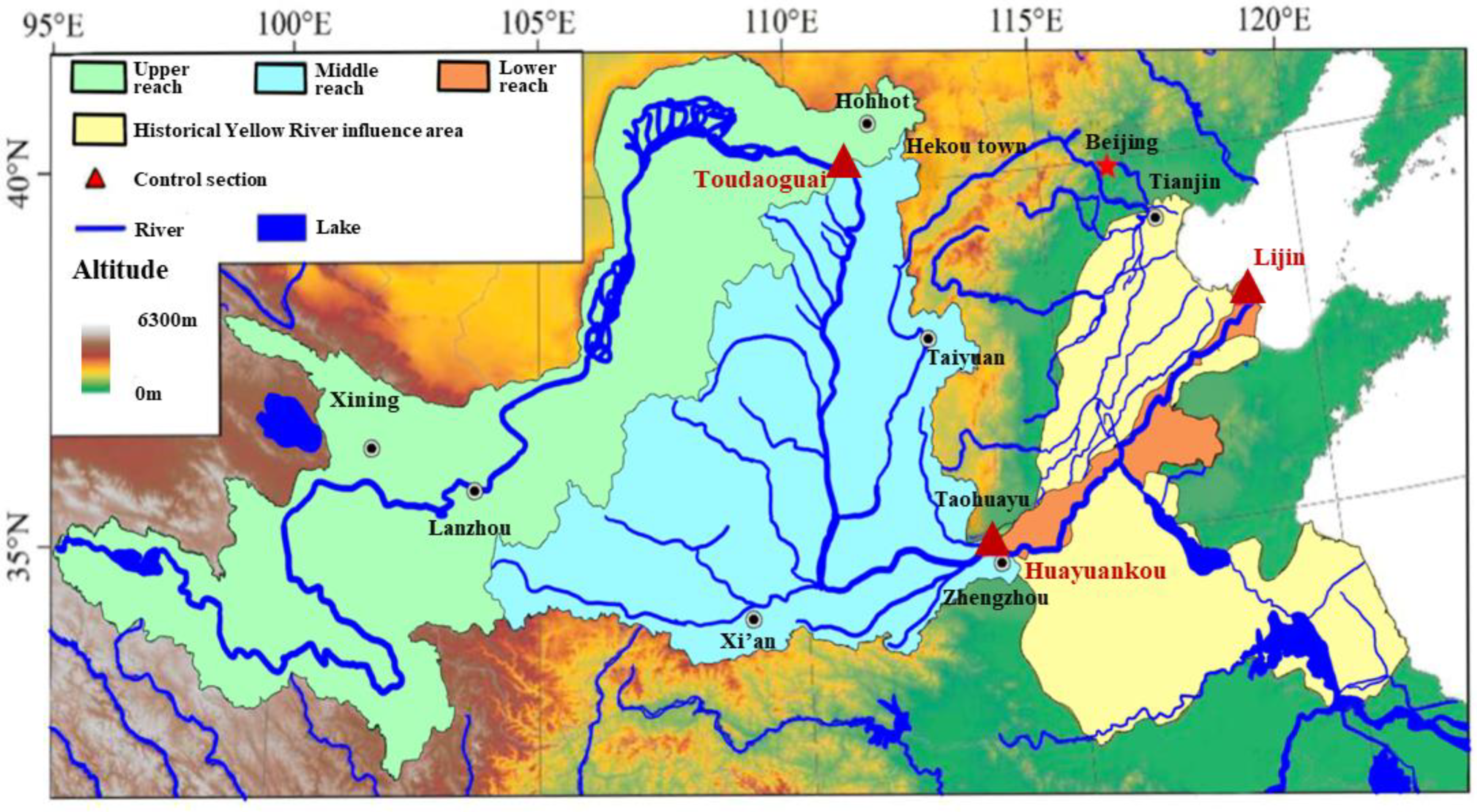
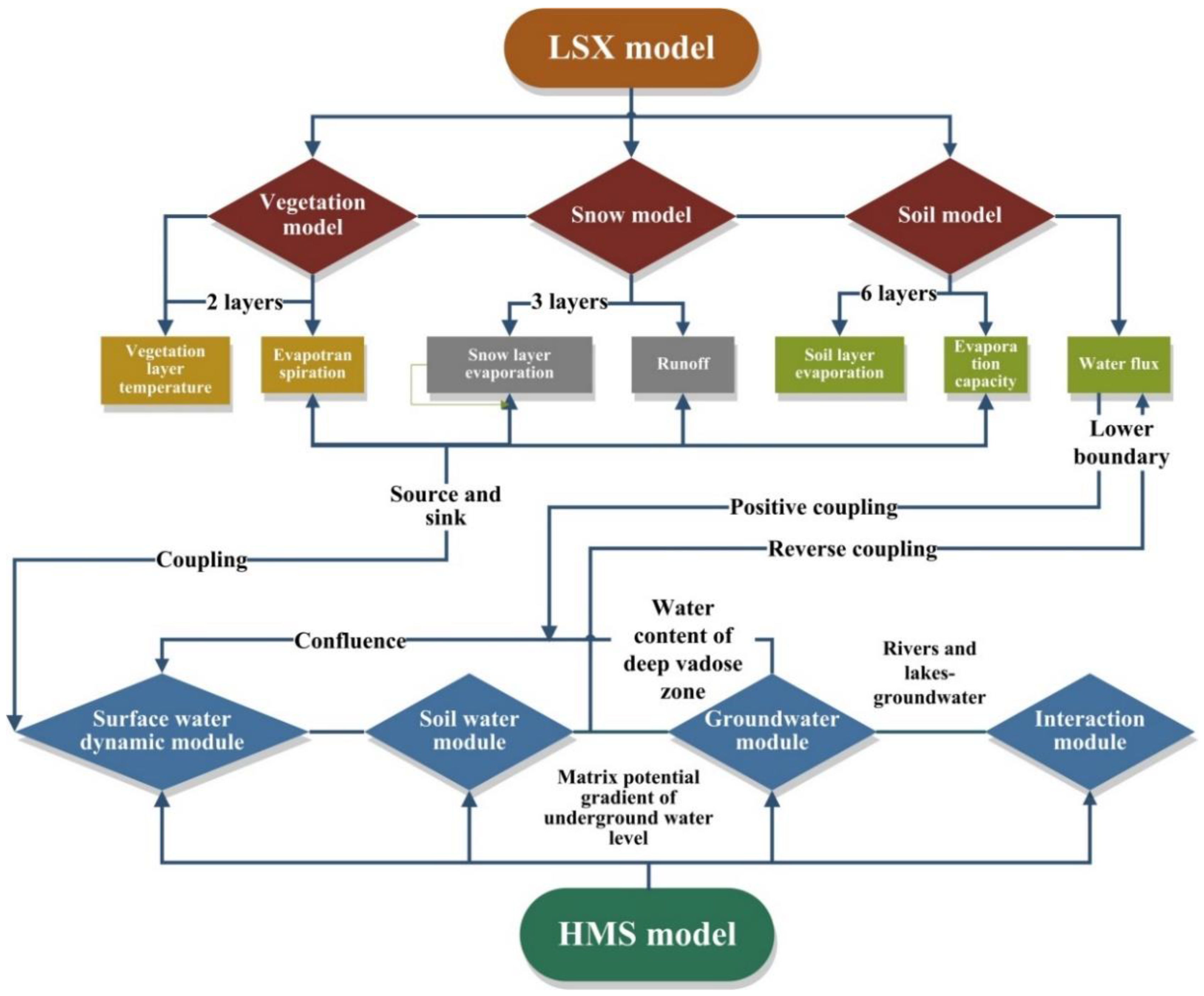


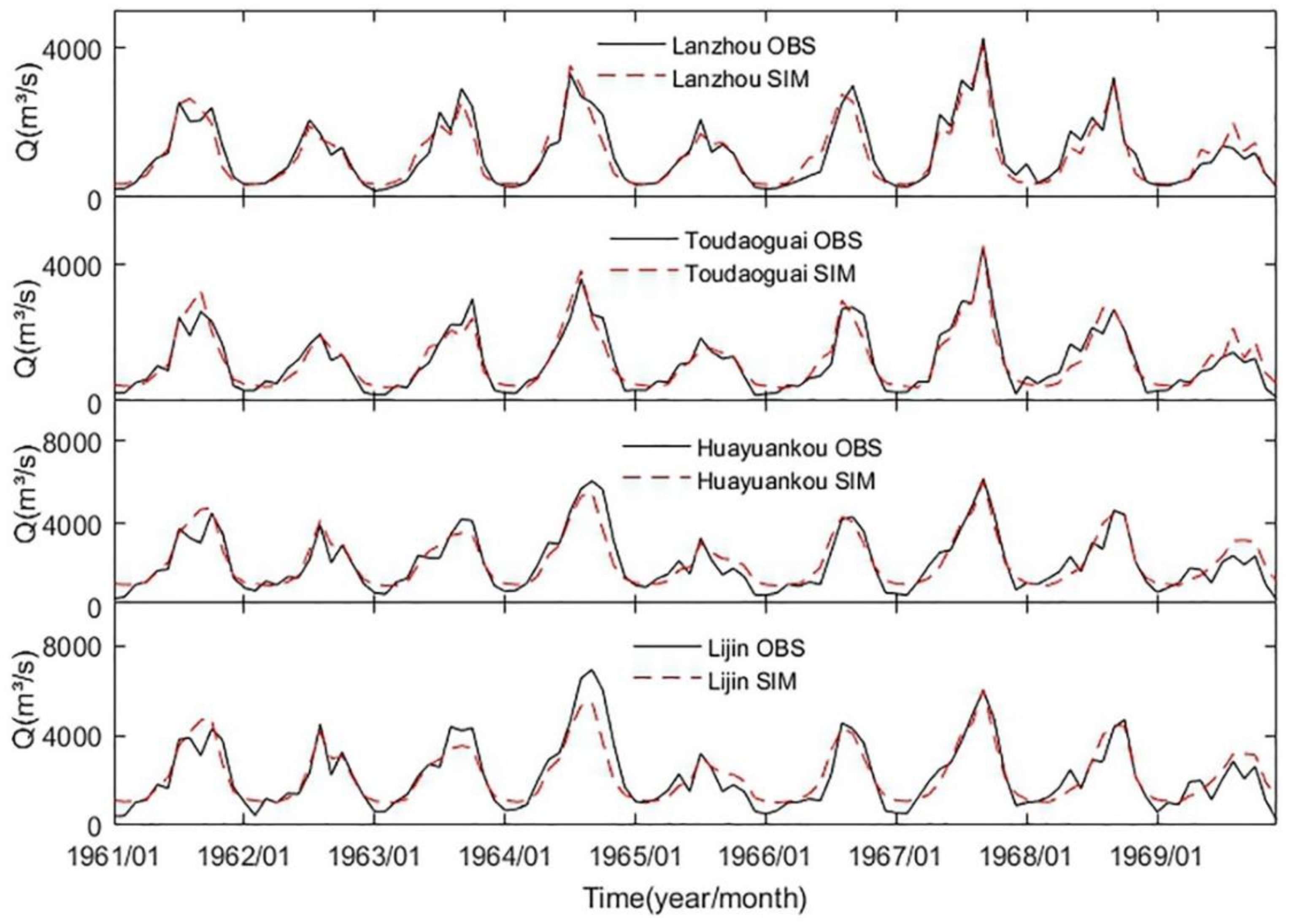
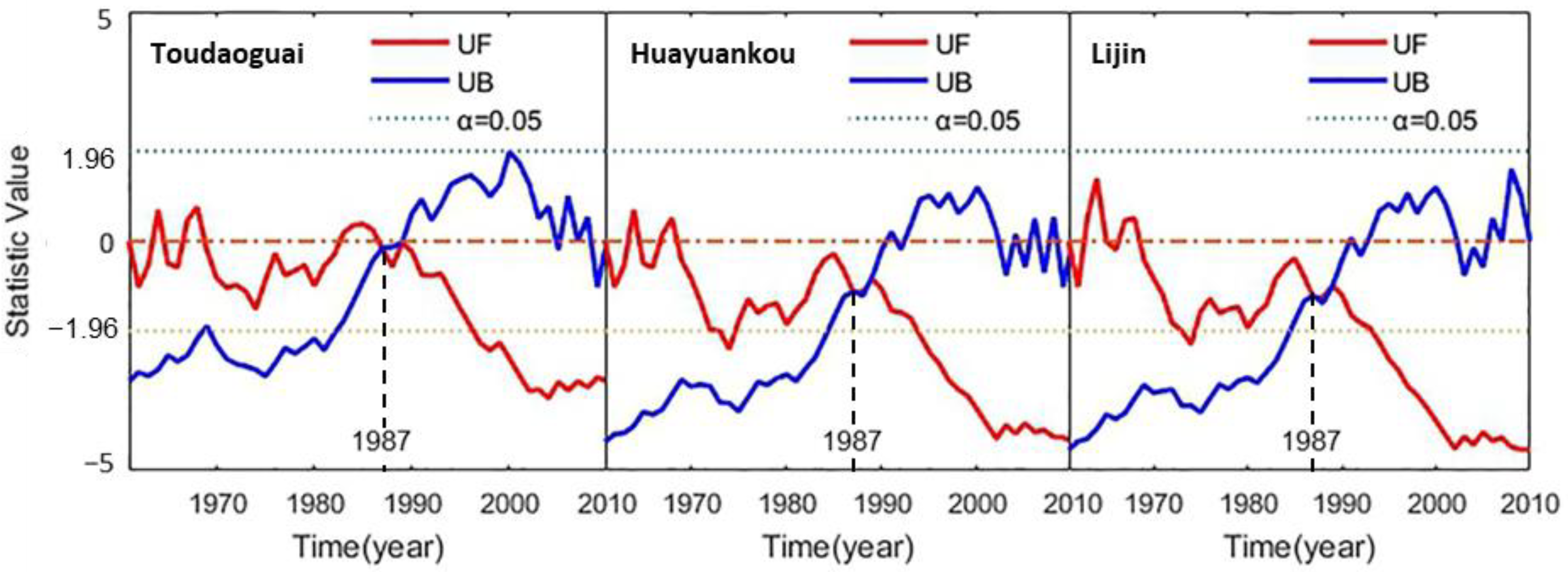
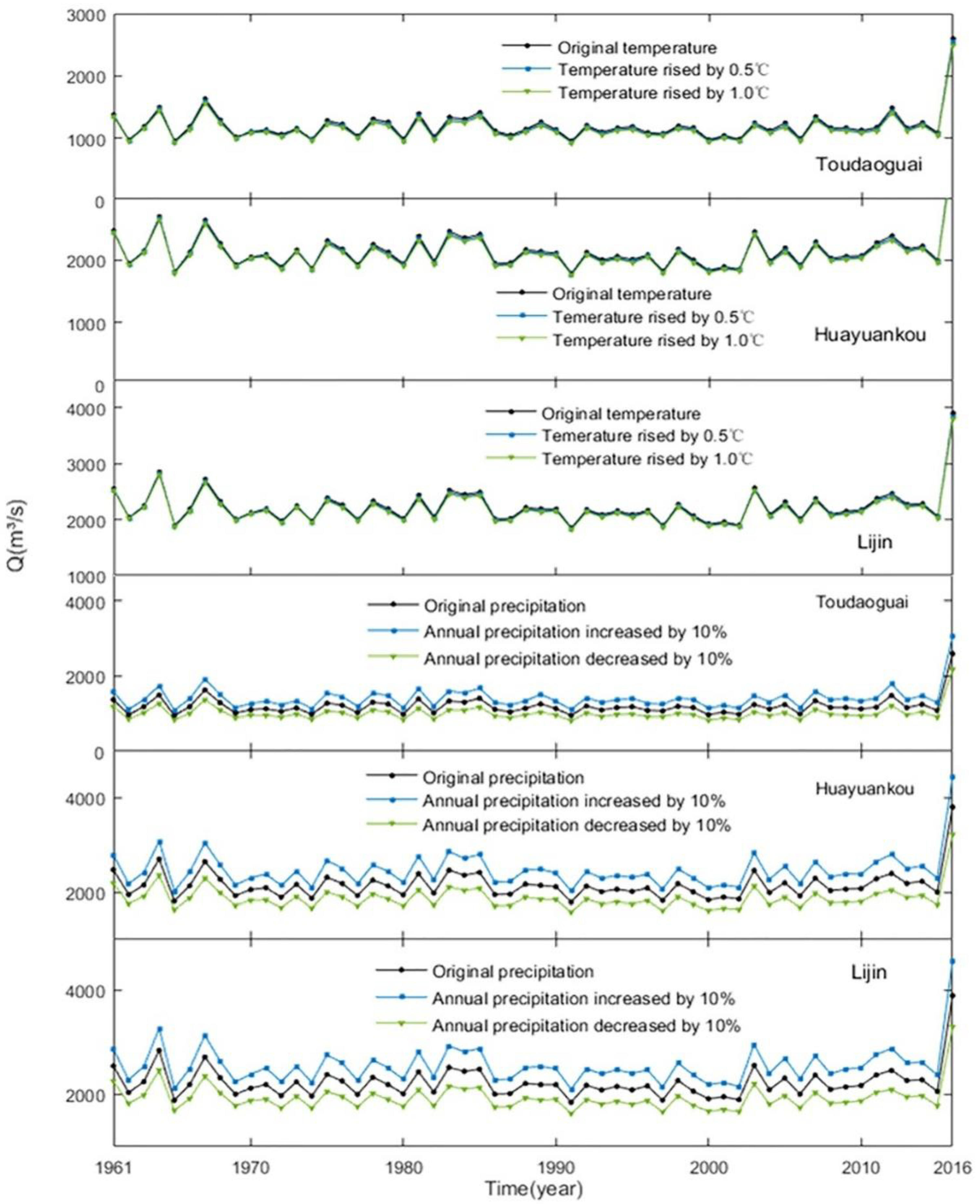
| Reach | Control Section | Region Division | River Length | Basin Area | Proportion |
|---|---|---|---|---|---|
| Upper reach | Toudaoguai | Above Hekou Town, Tuoketuo County, Inner Mongolia | 3471.6 | 42.8 | 53.8% |
| Middle reach | Huayuankou | From Hekou Town to Taohuayu, Zhengzhou City, Henan Province | 1206.4 | 34.4 | 43.3% |
| Lower reach | Lijin | Below Taohuayu | 785.6 | 2.3 | 2.9% |
| Total | 5463.6 | 79.5 | 100% | ||
| Data Type | Initial Source Data | After the Model Is Applied | |||||
|---|---|---|---|---|---|---|---|
| Source | Spatial Resolution | Time Resolution | Spatial Resolution | Time Resolution | Time-Space Sequence | ||
| Meteorological data | Precipitation and temperature | The latest 2472 national meteorological observatories on the ground in China (http://data.cma.cn accessed on 9 October 2022) | 0.5° × 0.5° | 24 h | 0.5° × 0.5° | 6 h (downscaling) | 1961~2018 |
| Specific humidity, wind speed, air pressure, infrared radiation, direct visible light, direct near infrared, scattered visible light, scattered near infrared, cloud cover | NCEP/NCAR reanalysis data | 1.875° × 1.875° | 24 h | 1.875° × 1.875° | 6 h (downscaling) | 1948~2018 | |
| Evaporation capacity | Measured data of large evaporating dishes in 45 evaporation stations in basin II | 1961~2017 | |||||
| Digital elevation and river depth | Digital elevation, cumulative flow distribution | Hydro SHEDS | 90 m | 20 km (upscaling) | Whole country | ||
| Vegetation and land use | Evergreen broad-leaved forest, deciduous broad-leaved forest, evergreen and deciduous mixed forest, coniferous broad-leaved forest, high-altitude deciduous forest, grassland, grassland/sporadic cultivated land, grassland/sporadic woodland, shrub and bare soil, lichen/moss, bare land and cultivated land | MODIS | 1 km | 20 km (upscaling) | Whole country | ||
| Soil | Sand and clay content | HWSD | 1 km | 20 km (upscaling) | Whole country | ||
| Simulated/Measured Parameters | Attribution Types and Effects | Time Series | ||
|---|---|---|---|---|
| Climate Change | Land Use | Water Conservancy Projects | ||
| × | × | × | Reference period | |
| Simulated flow | √ | × | × | Change periods |
| Naturalized flow | √ | √ | × | |
| Observed flow | √ | √ | √ | |
| Hydrologic Station | Lanzhou | Toudaoguai | Huayuankou | Lijin | ||||
|---|---|---|---|---|---|---|---|---|
| Indicators | NSE | BIAS | NSE | BIAS | NSE | BIAS | NSE | BIAS |
| Calibration period | 0.90 | 0.98 | 0.89 | 1.02 | 0.85 | 1.02 | 0.85 | 1.02 |
| Verification period | 0.90 | 0.97 | 0.89 | 1.02 | 0.86 | 1.067 | 0.84 | 1.10 |
| Section | Time | Measured Flow m3/s | Runoff Variation m3/s | Climate Change | Land Use | Water Conservancy Project | |||
|---|---|---|---|---|---|---|---|---|---|
| Flow Change m3/s | Contribution Rate % | Flow Change m3/s | Contribution Rate % | Flow Change m3/s | Contribution Rate % | ||||
| Toudaoguai (Upper reach) | 1987–1999 | 510.3 | −696.5 | −101.5 | 14.6 | −149.1 | 21.4 | −445.8 | 64.0 |
| 2000–2009 | 462.1 | −744.7 | −106.4 | 14.3 | −211.9 | 28.5 | −426.4 | 57.3 | |
| Huayuankou (Middle reach) | 1987–1999 | 861.6 | −1281.5 | −192.2 | 15.0 | −440.3 | 34.4 | −649.0 | 50.6 |
| 2000–2009 | 735.2 | −1407.9 | −174.2 | 12.4 | −615.2 | 43.7 | −618.5 | 43.9 | |
| 2010–2016 | 874.5 | −1268.6 | 193.2 | −15.2 | −828.4 | 65.3 | −633.5 | 49.9 | |
| Lijin (Lower reach) | 1987–1999 | 474.0 | −1728.4 | −207.2 | 12.0 | −471.2 | 27.3 | −1050.1 | 60.7 |
| 2000–2009 | 446.8 | −1755.7 | −175.2 | 10.0 | −670.0 | 38.2 | −910.5 | 51.8 | |
| 2010–2016 | 558.1 | −1644.3 | 191.5 | −11.6 | −841.5 | 51.2 | −994.3 | 60.4 | |
| Section | Scenario | Toudaoguai (Upper Reach) | Huayuankou (Middle Reach) | Lijin (Lower Reach) | |||
|---|---|---|---|---|---|---|---|
| Water Flow (m3/s) | Sensitivity (%) | Water Flow (m3/s) | Sensitivity (%) | Water Flow (m3/s) | Sensitivity (%) | ||
| Precipitation change | Measured precipitation | 1198.2 | 2148.6 | 2227.8 | |||
| Reduced by 10% | 1009.7 | −15.7 | 1873.7 | −12.8 | 1937.7 | −13.0 | |
| Increased by 10% | 1412.0 | 17.8 | 2454.9 | 14.3 | 2554.0 | 14.6 | |
| Temperature change | Measured temperature | 1198.2 | 2148.6 | 2227.8 | |||
| Increased by 0.5 °C | 1171.2 | −2.2 | 2123.0 | −1.2 | 2202.3 | −1.1 | |
| Increased by 1.0 °C | 1148.1 | −4.2 | 2101.2 | −2.2 | 2180.8 | −2.1 | |
| Year | Terrace | Plantation | Artificial Grass |
|---|---|---|---|
| 2000 | 2,989,583 | 5,439,562 | 1,129,242 |
| 2001 | 3,018,006 | 5,626,139 | 1,180,396 |
| 2002 | 3,127,109 | 5,942,315 | 1,251,785 |
| 2003 | 3,187,173 | 6,353,727 | 1,340,012 |
| 2004 | 3,249,599 | 6,688,022 | 1,400,168 |
| 2005 | 3,315,377 | 6,930,351 | 1,455,666 |
| 2006 | 3,376,576 | 7,124,452 | 1,510,179 |
| 2007 | 3,408,842 | 7,318,927 | 1,510,064 |
| 2008 | 3,415,145 | 7,383,969 | 1,881,860 |
| 2009 | 3,423,730 | 7,471,440 | 2,102,674 |
| 2010 | 3,458,880 | 7,487,907 | 2,330,178 |
| 2011 | 3,472,442 | 7,222,939 | 2,512,108 |
| 2012 | 3,493,737 | 7,467,613 | 2,578,059 |
Publisher’s Note: MDPI stays neutral with regard to jurisdictional claims in published maps and institutional affiliations. |
© 2022 by the authors. Licensee MDPI, Basel, Switzerland. This article is an open access article distributed under the terms and conditions of the Creative Commons Attribution (CC BY) license (https://creativecommons.org/licenses/by/4.0/).
Share and Cite
Chen, L.; Yang, M.; Liu, X.; Lu, X. Attribution and Sensitivity Analysis of Runoff Variation in the Yellow River Basin under Climate Change. Sustainability 2022, 14, 14981. https://doi.org/10.3390/su142214981
Chen L, Yang M, Liu X, Lu X. Attribution and Sensitivity Analysis of Runoff Variation in the Yellow River Basin under Climate Change. Sustainability. 2022; 14(22):14981. https://doi.org/10.3390/su142214981
Chicago/Turabian StyleChen, Liang, Mingxiang Yang, Xuan Liu, and Xing Lu. 2022. "Attribution and Sensitivity Analysis of Runoff Variation in the Yellow River Basin under Climate Change" Sustainability 14, no. 22: 14981. https://doi.org/10.3390/su142214981
APA StyleChen, L., Yang, M., Liu, X., & Lu, X. (2022). Attribution and Sensitivity Analysis of Runoff Variation in the Yellow River Basin under Climate Change. Sustainability, 14(22), 14981. https://doi.org/10.3390/su142214981








